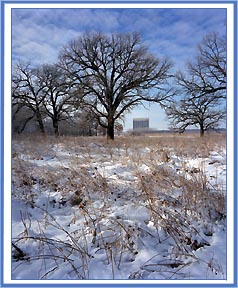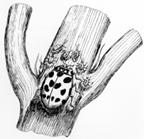Leon M. Lederman Science Education Center
Fermilab Flora and Fauna Virtual exhibit
Prairie Insects in Winter
Prairie Resources - Exhibit Home In spring, summer, and fall the
prairie is alive with insect activity. Bees hum, mosquitoes buzz,
butterflies and moths flit from flower to flower, crickets sing.
Where are all the pesky flies, mosquitoes and beetles in the winter?
What happens to the grasshoppers and the crickets? The prairie
insects have disappeared - but are they really gone?
In spring, summer, and fall the
prairie is alive with insect activity. Bees hum, mosquitoes buzz,
butterflies and moths flit from flower to flower, crickets sing.
Where are all the pesky flies, mosquitoes and beetles in the winter?
What happens to the grasshoppers and the crickets? The prairie
insects have disappeared - but are they really gone?
In cold weather most common insects cannot function. So, as winter nears, some insects look for shelter in the prairie soil. Some insects build their own houses, and some search for places to lay their eggs.
The honey bee queen and worker bees pile up into a ball in the center of the hive. The bees in the center are warm. The bees on the outside get cold, so they push their way into the middle of the ball. Those who were in the middle are pushed toward the outside of the ball. Therefore, the ball of bees keeps moving a little all the time.
Adult flies and mosquitoes find places outside in caves or holes in tree trunks - any place that offers a little protection from the cold. Most of them are females that mated during the summer. The eggs they carry inside them can develop into more flies and mosquitoes when spring comes.
Most species in the order Coleoptera (Beetles), have a life cycle of one generation a year. The winter may be passed in any of the life stages, depending on the species. Many overwinter as partly grown larva - they look like short worms and tunnel down into the ground; many overwinter as pupa in chambers in the soil or in wood or in other protected areas, and many overwinter as adults. For example ground beetles and cucumber beetles dig down into the ground where it is warmer.
Some butterflies, like many birds, migrate to warmer areas for the winter. Other hardier species will rest in tree trunks or on branches until spring. Still others will spend the winter in various stages of development - egg, larva or pupa. Most commonly, butterflies winter in the pupa stage as does their relatives, the moths.
The prairie in winter is cold and snow-covered and the ground is frozen. But hidden away are the insects that keep the prairie alive with sound and activity during the spring, summer and fall seasons. Winter is quiet and pristine on the prairie, but not completely still. Can you find the wintering insects?
 Ladybird Beetles "Ladybugs"
(family Coccinellidae)
Ladybird Beetles "Ladybugs"
(family Coccinellidae)
In the fall these beetles gather in groups making it easy for farmers to collect and transport them to the farms for pest control. However, the ladybugs' reason for gathering is to prepare for winter by piling one on top of the other in tree stumps or under rocks and leaves to protect themselves from the winter cold.

Grasshopper (family Tettigoniidae {long-horned})
In the fall the female grasshopper drills deep holes in the prairie soil by pushing the tip of her abdomen into the ground and squeezing out twenty to a hundred eggs. She swallows air to blow up her abdomen so it can push deeper into the soil. She covers the eggs with a white froth which soon forms a hard case to protect the eggs. She dies, but the eggs last through the winter and then hatch into tiny grasshoppers.

Crickets (family Gryllidae)
The female cricket also lays eggs in the prairie soil and dies soon after. She lays a few hundred eggs by using the needle-like ovipositor at the tip of her abdomen to drill holes into the earth. Each egg is in a separate hole, about half an inch deep. The eggs, in which tiny cricket nymphs are forming, are protected underground from the cold winter weather. If the tiny crickets survive their predators and the cold, a new generation of crickets will emerge in the springtime.

Tiger Beetles (family Cicindelidae)
On a sunny day, an iridescent green beetle with six yellow spots, the six-spotted tiger beetle, is in the prairie. When the sun gets lower in the sky and the air begins to cool, the beetle bores underground where it will stay for the winter. The larva which hatches from eggs laid in the ground also stays underground where it is warmer.

Moths (order Lepidoptera)
In the fall, a close look reveals eggs and caterpillars on the leaves of plants. Some moths spend the winter as eggs or caterpillars wrapped in leaves for warmth, but most spend the winter in the pupa stage. The pupa builds a cocoon from silk or bits of wood or a leaf glued together with silk. In the spring the moth emerges from the cocoon.